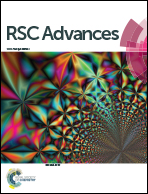Clerodane diterpenes from Polyalthia longifolia var. pendula protect SK-N-MC human neuroblastoma cells from β-amyloid insult†
Abstract
Three new diterpenes, polylongifoliaic A (1), polylongifoliaons A (4) and B (5), together with nine known diterpenes, were isolated from the unripe fruits of Polyalthia longifolia var. pendula. The structures of the new isolates were determined by extensive spectroscopic analysis. The effects of all the isolated compounds on the viability of human neuroblastoma SK-N-MC cells under β-amyloid (Aβ)-induced neurotoxicity were evaluated. Polylongifoliaic A (1), polylongifoliaon B (5) and 8–10 improved the viability of human neuroblastoma cells (SK-N-MC cells) under Aβ-induced neurotoxicity. Among the active compounds, polylongifoliaic A (1) and polylongifoliaon B (5) exhibited the most potent activity toward SK-N-MC cells with IC50 values of 1.64 μM and 3.75 μM, respectively. In addition, the isolated diterpenes were found to possess potent promising acetylcholinesterase inhibitory activity, which was revealed by the TLC bioautographic assay.


 Please wait while we load your content...
Please wait while we load your content...